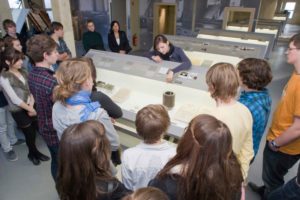At Erfurt, the former administrative building of the “builders of the Auschwitz ovens” is now a memorial center also engaging with current issues…

Former headquarter of Topf & Söhne – now a memorial place
(c) Pichler Architekten Köln

In the exhibition
(c) by Dirk Urban
The moral debasement that resulted from this willing complicity is exemplified by Karl Prüfer (1891−1952), Topf & Söhne’s head engineer. In his early career, Prüfer had worked in the areas of waste disposal, cremation of animal corpses, and the design and construction of municipal crematoria. In 1931, Prüfer would still write, “cremation should not be debased simply to a means of cadaver disposal.” But the ovens that he would later design for the SS were intended for one purpose only: mass disposal of human beings.
Alongside historical documentation, the memorial center also focuses on questions of remembrance work and engagement with current issues. Among its notable initiatives was the November 2011 public commemoration of the victims of far-right murders, as well as several events held in commemoration of the genocide in Rwanda. The numerous educational activities of the center include eyewitness testimony such as the accounts of Hungarian Auschwitz survivor Eva Fahidi-Pusztai, discussions about recent developments in right-wing populism and extremism as well as media reports on the topic, and discussions of the nature of complicity and business ethics as a whole. The center also hosts workshops for refugees living in Thuringia and for Muslim university students on topics such as human rights and democracy. The memorial website includes a “web dialogue” section where online visitors can post their own contributions.
In the early years, there were some who argued that the memorial was harming Erfurt’s image and “soiling its own nest.” An argument to which then-head of the Jewish community of the state of Thuringia, Wolfgang Nossen, commented: “You should have given some thought to the city’s image 80 years ago!” Today the memorial is welcomed by the city and its citizens, as is also evident by its close collaboration with other local institutions. One teacher from Norway commented: “When I go home tomorrow, I’ll have questions, questions, questions.” The exhibition “Industry and Holocaust” is shown at the Auschwitz-Birkenau State Museum until the end of October. For American audiences, an English and Spanish language version is available.
